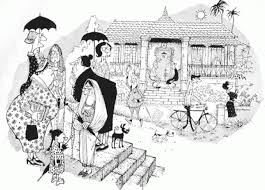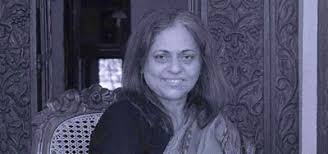
Ever since the
Indian army marched in and annexed the Portuguese State of India to the Union,
Goan society has been involved in an incredibly intense churning. This churning
has occurred as Goans sought, and continue to seek, their location within the
larger Indian polity; as they sought to make sense of the rapid changes that
overturned the social structures of a highly stratified society held in place
through late Portuguese imperialism; as new elites emerged and waves of, until-then,
foreigners landed up to radically transform the Goan landscape. A churning that
has been on for some decades now, it would not be wrong to say that this
process reached a particularly intense moment in the past couple of years. It
is within this context that
Let me tell
you about Quinta should be read, evaluated and appreciated. A good number
of Goan, and non-Goan artists, musicians and writers have attempted to grapple
with the upheavals that have beset Goan society, and it must be said that
Let me tell you is clearly one of the
finer products of that churning.

Set in the
village of Carmona,
Let me tell you about
Quinta is narrative that spans three generations (including an illegitimate
one) of a Catholic
bhatcar (i.e. landed Goan)
family and its multiple Others. Weaving between time-periods, pre-colonial, colonial
and the post-colonial, the narrative is punctuated by the voice of the initial
narrator of the epic, and the figure closest in time to us; the readers. Indeed,
the delicate texture of time that this narrative produces is one of the finer
features of this book, fine-grained in its attention to detail, yet never
leaving one exhausted from the burdens of history. And yet, the central
protagonist of the narrative is clearly
Quinta
do Santo Antonio the highly contested property that, like so many Goan
homes and properties of the late-colonial epoch, framed the emergence, lifestyles
and the eventual dissolution of one class and the burgeoning of another. This
grand Goan home, like others in the territory, measured carefully the lives its
owners would lead, and mapped the relationships they would enjoy or suffer with
their relatives and minions; living on, even as the eaves of these homes
eventually come crashing down. It should be said, that one could use this one
book as a fairly effective way into getting into a broad and yet sensitive
understanding of Goan society and its history.
 Let me tell you
Let me tell you however, does not limit
itself to merely weaving its tale via reference to the quotidian. On the
contrary, the magical or the enchanted trespass quite frequently into the tale,
be it in the form of birthing fluids that deluge automobiles, women who speak
quite casually to spirits that tattle tales of buried wealth, and curses that
eventually ruin families. If it were just this however,
Let me tell you would fall well into the realm of fantasy, or
magical realism. However, because the fantastic that the narrative presents are
from well within the vernacular traditions of Goa, this book is poised quite
comfortably within the realm of contemporary mythology. The most exciting
feature of this book therefore is not the deft weaving of Goan history, or its
sociological insight, but the manner in which it has done both of these while
integrating the same into the spiritual traditions of the land. Most efforts on
this front, especially by Goan Catholic authors tend to tumble headlong into an
embrace of brahmanical myth, as they thrash about seeking to recreate the
history of a Hindu past that they believe they have lost. Not so
Let me tell you, that catholically
embraces the fluid movements of Goan history while simultaneously rooting itself
in a living and breathing mythological traditions of village Goa, or perhaps
more appropriately village Salcette (the
taluka
within which the novel is so firmly set.)

Because
Let me tell you emerges from out of this
great Goan soul-searching, because it is located within the mythos of the Goan
space,
and because it is cognizant of
the nuances that time has wrought on this space, it is an intensely political
text. Like the time-frame of the narrative, this commentary is pronounced upon
various locations of Goan time, not restricting itself merely to the
contemporary moment. However, because it is
Quinta
that is the central figure of the book, the most fundamental comment is the
lament for the loss of the Goan homes and the families that built them. Take for
example this hugely evocative “‘What a life’ wrote Preciosa to Sun, ‘this was a
land of open door, now we have to lock ourselves in to avoid people.’”
And yet, while the narrative mourns the
passing of an age, because it reflects on the morality of the actions that
built and sustained those home, and eventually came to pass, it is a cathartic lament,
creating through this narrative the legitimate space for those former
subalterns, the minions of homes like
Quinta
do Santo Antonio who have now come to succeeded to the Goan earth that they
were so long disinherited from.

For the
dexterity with which Savia Viegas weaves these many projects together, for its
breathless and graphic storytelling, the book is an intellectual delight even
if one is not interested in Goa, its politics or its history. Indeed, because
of the manner in which it involves itself with the genealogies of a creole
society, a number of readers have commented on, and drawn parallels with the
works of Marquez and Allende. However, those unfamiliar with the nuances of
Goan cuisine, language, hierarchies and idiosyncrasies may at times find it
difficult to navigate and make sense of the narrative. Viegas, or the
publishers Penguin, would have been well advised to include a glossary along
with the narrative. However, one could also perhaps simultaneously discern from
this lack of a glossary, the decision to pluck Goa away from its location as an
aberration, where it is merely ‘a small part of India’ and return to it its
universal significance. While on the subject of language, it should also be
said that the few forays that the narrative makes into other languages, be it
Hindi, Konkani or Portuguese detract from the breathless beauty of the narrative.
One can understand the temptation to invoke the vernaculars to give a flavor of
the land, but given Viegas’ skills that have thus far been acclaimed, these
little flourishes serve only a cloying flavor that could have well be dropped.
Introducing the vernacular tongue into a text written in a different idiom is
seldom easy, and this attempt is not Viegas’ brightest moment. There is another
grumble associated with language and this one involves the dropping of the
accents that communicate the sounds of the Portuguese language used in the
book. This, along with spelling errors, is often a ‘mistake’ committed by
Anglophone publishers of texts that invoke languages other than English. For a
text that seeks to weave the Portuguese language convincingly into its
narrative however, this is an appalling oversight.

The last of the
grumbles associated with the production of this book involves the images
located in the text. Five in number, Viegas commences each part of this
four-fold narrative with a pictograph assumedly crafted by her hand. These
images share an interesting relationship with the text. Not quite a
show-and-tell, it is as if these images are the remnants of the dreams from
which the narrative was born. Given that these images would been executed in colour,
and given their association with the text, it is a shame that they appear in
the book not in the lavish colour or Viegas’ no doubt technicolour dreams, but
in muted and disappointing shades of greys.
Savia Viegas’s
book is a delight at so many levels; so do, do let her tell you about Quinta.
Let Me Tell You About Quinta
By Savia Viegas
Penguin Books India, New Delhi, 2011, 254 pp., Rs 299
ISBN 0143415220

No comments:
Post a Comment